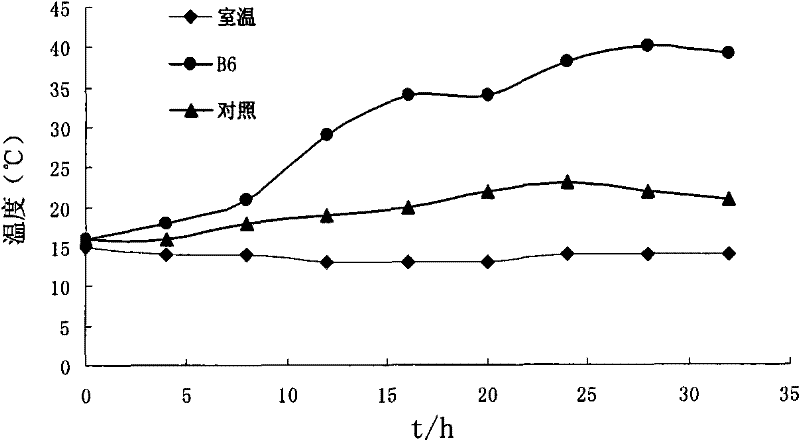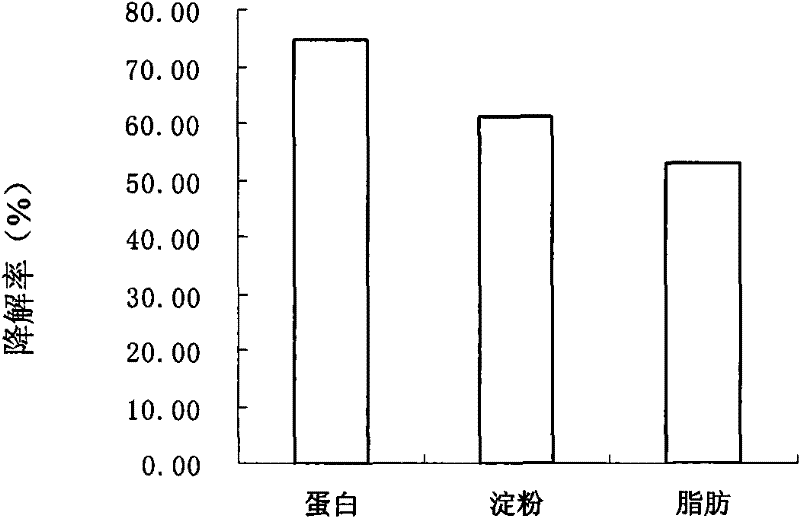Aeromonas 6-38 and application thereof
A technology of Aeromonas and strains, which is applied to Aeromonas 6-38 and its application in low-temperature solid waste composting treatment, can solve the problems of reducing composting efficiency and prolonging the decomposition cycle of organic wastes.
- Summary
- Abstract
- Description
- Claims
- Application Information
AI Technical Summary
Problems solved by technology
Method used
Image
Examples
Embodiment 16-38
[0027] The identification of embodiment 16-38 bacterial strain
[0028] 1.1 Physiological and biochemical assays
[0029] The isolated bacterial strain (preservation number is CGMCC No.4402) is identified, and the method for physiological and biochemical determination is according to the standard method (Bacterial Taxonomy Group, Institute of Microbiology, Chinese Academy of Sciences, 1978; Dong Xiuzhu, Cai Miaoying, etc., 2001), part of the physiological and biochemical The traits are shown in Table 1.
[0030] Table 1 Physiological and biochemical identification of bacterial strains
[0031]
[0032] 1.216S rDNA sequence analysis
[0033] After inoculating strain 6-38 in liquid LB medium and shaking culture for 24 hours, take 1 mL of the bacterial liquid in a 1.5 mL centrifuge tube, and collect the bacterial cells after centrifugation at 12000 r / min for 3 min;
[0034] Add 567 μL of TE buffer to the bacteria and shake to fully suspend the cells; add 30 μL of 10% SDS, 3...
Embodiment 2
[0048] 1) Slant culture: inoculate 6-38 original strains on LB solid medium under sterile conditions, and cultivate at 25°C for 2-6 days to activate the strains;
[0049] 2) First-level seed cultivation: inoculate 10% of the bacteria cultured in step 1) into 5ml of LB liquid medium by volume ratio under aseptic conditions, and culture them on a shaker at 100-200r / min for 2-6 hours at 25°C. days, single strain liquid culture OD 600 When the value is between 1.5-2.4, the cultivation is stopped, and the first-grade seeds are obtained;
[0050] 3) Secondary seed culture: Inoculate the primary seeds in 1L of LB culture medium at an inoculum volume of 5-20% according to the volume ratio of the liquid medium, and inoculate them on a shaker at 100-200r / min at 25°C Cultivate for 2 to 6 days, and the bacterial concentration reaches 10 8 -10 9 cfu / mL, mixed with the matrix corn flour at a ratio of 600g / L to obtain the bacterial agent.
Embodiment 3
[0052] The inoculum prepared in Example 2 was added to the compost system, and the inoculum prepared by the mesophilic strain Bacillus megaterium (1.2393) (purchased from China Common Microorganism Culture Collection Center) was used as a control, and chicken manure and sawdust were used as compost Material, adjust the C / N ratio to 28, moisture 60%, compost at room temperature of 13-15°C, measure the temperature change of the compost every 5h, the results are shown in Table 1, the results show that the 6-38 do The temperature of the inoculant pile reached 39.6°C at 28 hours, and the temperature of the pile made of the inoculum by the mesophilic strain Bacillus megaterium reached 30.1°C.
PUM
 Login to View More
Login to View More Abstract
Description
Claims
Application Information
 Login to View More
Login to View More - Generate Ideas
- Intellectual Property
- Life Sciences
- Materials
- Tech Scout
- Unparalleled Data Quality
- Higher Quality Content
- 60% Fewer Hallucinations
Browse by: Latest US Patents, China's latest patents, Technical Efficacy Thesaurus, Application Domain, Technology Topic, Popular Technical Reports.
© 2025 PatSnap. All rights reserved.Legal|Privacy policy|Modern Slavery Act Transparency Statement|Sitemap|About US| Contact US: help@patsnap.com



